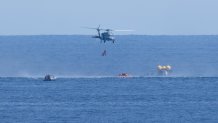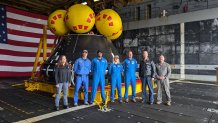NBC 7 and Telemundo 20’s Ana Cristina Sánchez has more on the mission and how NASA and the Department of Defense are preparing for the real thing.
Off the San Diego coast, a team from NASA and the U.S. Navy are conducting critical astronaut recovery drills in preparation for the space agency's first attempt in 50 years to transport humans to the moon.
This exercise, known as Underway Recovery Test 12, is essential to ensure that the splashdown and recovery of the Artemis II crew is carried out smoothly after the astronauts' journey of more than 600,000 miles to the Moon and back.
The Artemis II mission, scheduled to launch in the coming months, will be the first crewed mission under NASA's Artemis program. The first stage of the three-leg mission, Artemis I, was complted with an unmanned space vessel in 2022.
During this mission, the astronauts will travel approximately 4,600 miles beyond the far side of the Moon, making the crew on board the first to ever travel beyond the moon.
Get top local stories in San Diego delivered to you every morning. Sign up for NBC San Diego's News Headlines newsletter.

Image Credit: NASA/Joel Kowsky
The recovery team, made up of highly trained personnel from NASA and the Department of Defense, have practiced the recovery operations to make sure the astronauts are safely and quickly recovered after splashdown in the Pacific. These drills include simulating real-life splashdown conditions, both day and night, and using inflatable rafts to assist in extracting the astronauts from the Orion capsule. The splashdown is expected to happen 60 miles off the Southern California coast, somewhere in between Catalina Island and San Clemente.
"These exercises are vital to the success of the Artemis II mission," said Liliana Villarreal, NASA’s Recovery Director. "We ensure that every team member is prepared for any eventuality, guaranteeing the safety of our astronauts."

The collaboration between NASA and the U.S. Navy is not new, but it is very important to the success of space missions. The capability of amphibious transport ships, such as the USS Somerset, provides the perfect environment for these complex operations, combining advanced technology with the expertise of highly trained sailors.
Local
With the Artemis II mission, NASA aims not only to explore deep space but also to establish a sustainable presence on the Moon, with future mission plans that include the construction of the Gateway in lunar orbit. According to experts, these rescue drills are a crucial step toward that ambitious goal.
Artemis III is planned to be the second crewed Artemis Mission and the first crewed lunar landing since Apollo 17 in 1972.



